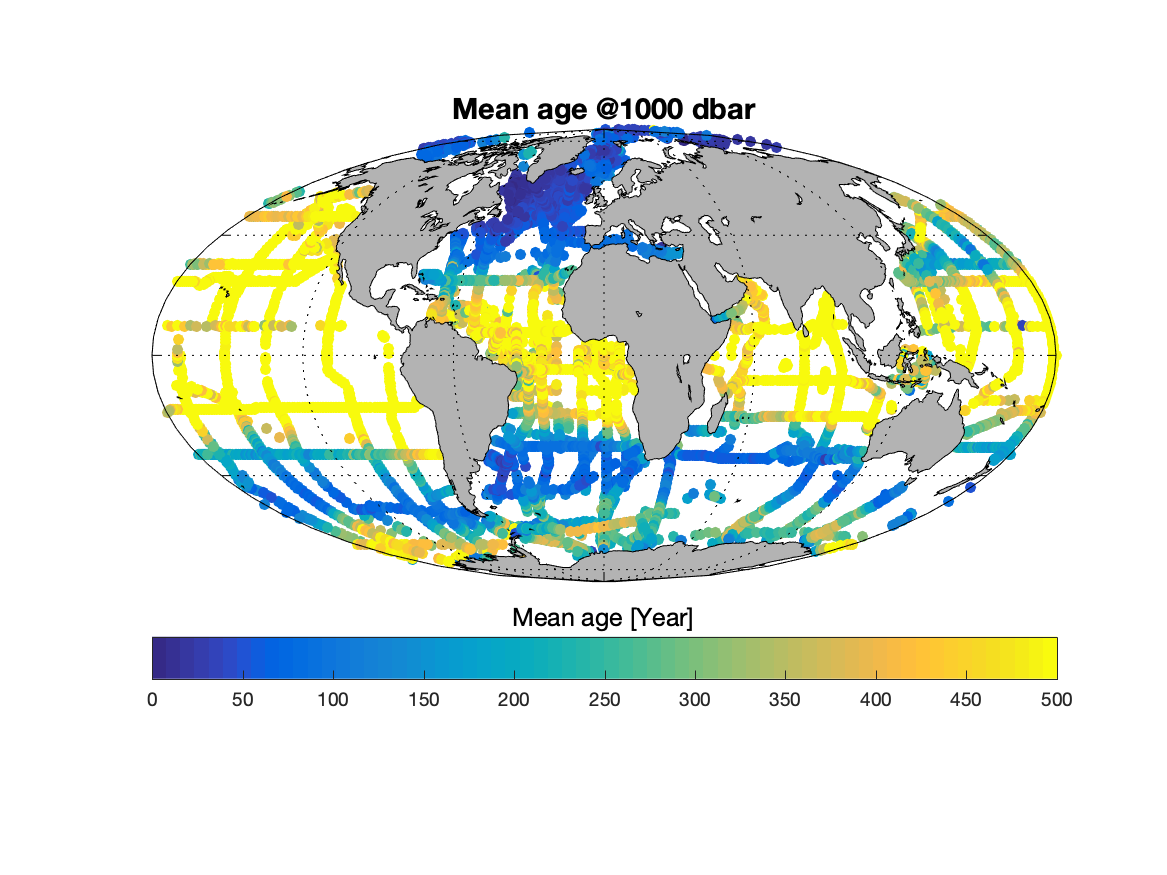NDP-108 (2021)
NCEI Accession 0226793, NDP-108 Data and Documentation Files
Water mass ages based on GLODAPv2 data product (NCEI Accession 0226793)
Emil Jeansson1, Reiner Steinfeldt2 Toste Tanhua3
Prepared by Alex Kozyr4
1NORCE Norwegian Research Centre, Bjerknes Centre for Climate Research, Bergen, Norway;
2University of Bremen, Bremen, Germany;
3GEOMAR Helmholtz Centre for Ocean Research Kiel, Marine Biogeochemistry, Chemical Oceanography Düsternbrooker Weg 20, 24105 Kiel, Germany;
4National Centers for Environmental Information (NCEI), National Oceanic and Atmospheric Administration (NOAA), Silver Spring, MD, USA.

Abstract
This NCEI accession contain ventilation ages calculated using the transit time distribution (TTD) method (e.g., Waugh et al., 2004) on the GLODAPv2 data synthesis product (Olsen et al., 2016). Ventilation age is defined as the time elapsed since a water parcel was last in contact with the atmosphere. Our calculated ages are estimated from measured concentrations of the transient tracers’ sulphur hexafluoride (SF6), and the chlorofluorocarbons (CFCs) CFC-11 and CFC-12.
For these TTD calculations we have assumed full (100%) saturation of the transient tracers when subducted, which will generate a bias toward older ages in especially dense water formation regions since it is known that the saturation there is frequently lower than 100%. We assume that the solution to the Greens function is an Inverse Gaussian (IG) function. Furthermore, we have assumed a balance between advection and mixing, i.e., unity ratio between the width and the mean age of the TTDs. This assumption is typically adopted in the global ocean (e.g., Waugh et al., 2006), although there is regional variability (e.g., Stöven and Tanhua, 2014; Rajasakaren et al., 2019). Thus, some care should be taken when utilising the calculated ages in certain regions. The main reason for the published dataset is to give a user-friendly product that can be applied in ocean studies where ventilation ages are of interest, both to give an appreciation of typical ages and gradients in the ocean, and to be adopted in studies calculating biogeochemical rates. A recent example of the latter is the updated calcium carbonate dissolution study by Sulpis et al. (2021), which used these data.
All included data are listed and specified in the dataset description below, and most of them are identical to the values found in GLODAPv2 (Key et al., 2015; Olsen et al., 2016). The novel addition in this accession are the ventilation ages. The files contain both the TTD-based mean ages that are calculated as described above, and, calculated tracer ages, which assumes no mixing and are simply derived by matching the observed tracer concentration to the atmospheric history.
For the atmospheric history we used (Walker et al. (2000) and Bullister (2015)), updated to 2016 by extrapolating with the same atmospheric evolution rate as the year before.
The accession consists of files covering four regions, following the GLODAPv2 data synthesis product: the Arctic Mediterranean (ARC), The Atlantic Ocean (ATL), the Indian Ocean (IND), and the Pacific Ocean (PAC). The data are provided both in comma separated (.csv) format and in Matlab® format (.mat).
Please cite this data set as:
Jeansson, Emil; Steinfeldt, Reiner; Tanhua, Toste (2021). Water mass ages based on GLODAPv2 data product (NCEI Accession 0226793). NOAA National Centers for Environmental Information. https://doi.org/10.25921/xp33-q351.
Dataset description:
EXPOCODES.txt file: -cruise number and expocode: EXPOCODE for each cruise in GLODAPv2
Gv2_*_age files: -cruise: cruise numbers in GLODAPv2 -Year, Month, Day -latitude: latitude in degrees north -longitude: longitude in degrees east -pressure: pressure in dbar -salinity: salinity -temperature: in situ temperature in degrees Celsius -theta: potential temperature in degrees Celsius -sf6: sulphur hexafluoride (SF6) in fmol kg-1 -cfc11: chlorofluorocarbon-11 (CFC-11) in pmol kg-1 -cfc12: chlorofluorocarbon-12 (CFC-12) in pmol kg-1 -psf6: partial pressure of SF6 in ppt -pcfc11: partial pressure of CFC-11 in ppt -pcfc12: partial pressure of CFC-12 in ppt -ageSF6: tracer age calculated from SF6 in years -ageF11: tracer age calculated from CFC-11 in years -ageF12: tracer age calculated from CFC-12 in years -mageSF6: mean age calculated from SF6 and the TTD method in years -mageF11: mean age calculated from CFC-11 and the TTD method in years -mageF12: mean age calculated from CFC-12 and the TTD method in years
References
Bullister, 2015. Atmospheric Histories (1765-2015) for CFC-11, CFC-12, CFC-113, Tech. Rep. NDP-095, Carbon Dioxide Information Analysis Center, Oak Ridge National Laboratory, US Department of Energy, Oak Ridge, Tennessee, doi:10.3334/CDIAC/otg.CFC_ATM_Hist_2015.
Key, R., Olsen, A., van Heuven, S., Lauvset, S.K., Velo, A., Lin, X., Schirnick, C., Kozyr, A., Tanhua, T., Hoppema, M., Jutterström, S., Steinfeldt, R., Jeansson, E., Ishi, M., Perez, F.F., Suzuki, T., 2015. Global Ocean Data Analysis Project, Version 2 (GLODAPv2), ORNL/CDIAC-162, NDP-093. Carbon Dioxide Information Analysis Center, Oak Ridge National Laboratory, US Department of Energy, Oak Ridge, Tennessee. doi: 10.3334/CDIAC/OTG.NDP093_GLODAPv2.
Olsen, A., Key, R.M., van Heuven, S., Lauvset, S.K., Velo, A., Lin, X., Schirnick, C., Kozyr, A., Tanhua, T., Hoppema, M., Jutterström, S., Steinfeldt, R., Jeansson, E., Ishii, M., Pérez, F.F., Suzuki, T., 2016. The Global Ocean Data Analysis Project, version 2 (GLODAPv2) – an internally consistent data product for the world ocean. Earth Syst. Sci. Data 8, 297-323, https://doi.org/10.5194/essd-8-297-2016.
Rajasakaren, B., Jeansson, E., Olsen, A., Tanhua, T., Johannessen, T., Smethie, W. M., Jr. (2019). Trends in anthropogenic carbon in the Arctic Ocean. Prog. Oceanography, 178, https://doi.org/10.1016/j.pocean.2019.102177.
Stöven, T., Tanhua, T. (2014). Ventilation of the Mediterranean Sea constrained by multiple transient tracer measurements. Ocean Sci., 10, 439-457, https://doi.org/10.5194/os-10-439-2014.
Sulpis, O., Jeansson, E., Dinauer, A., Lauvset, S.K., Middelburg, J.J., 202. Calcium carbonate dissolution patterns in the ocean. Nature Geosci., 14, 423-428, https://doi.org/10.1038/s41561-021-00743-y.
Walker, S. J., Weiss, R. F., Salameh, P. K., 2000. Reconstructed histories of the annual mean atmospheric mole fractions for the halocarbons CFC-11, CFC-12, CFC-113 and carbon tetrachloride. J. Geophys. Res. 105(C6), 14285-14296, doi:10.1029/1999JC900273.
Waugh, D. W., Haine, T. W. N., Hall, T. M. (2004). Transport times and anthropogenic carbon in the subpolar North Atlantic. Deep Sea Res. I, 51, 1475-1491.
Waugh, D. W., Hall, T. M., McNeil, B. I., Key, R., Matear, R. J. (2006). Anthropogenic CO2 in the oceans estimated using transit time distributions. Tellus, 58B, 376-389.
